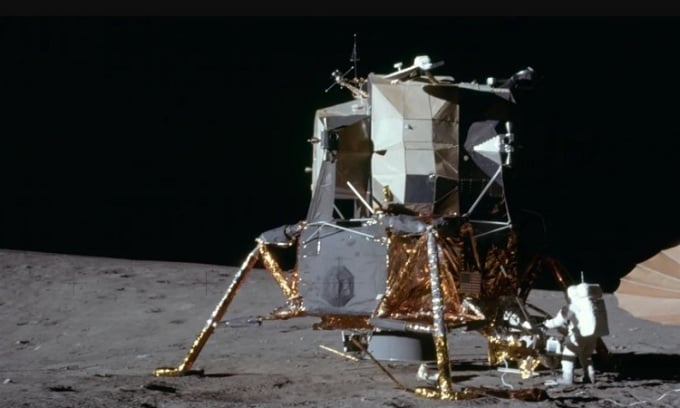An American engineer named Jack Garman helped the Apollo 11 mission land on the Moon as planned after finding an alarm error in the control computer.

The Eagle landing station carried Neil Armstrong and Buzz Aldrin to the Moon on July 20, 1969. Photo: NASA
In 1969, John "Jack" Garman worked at NASA's Mission Control Center at the Johnson Space Center in Houston, Texas. He was a computer engineer, helping to ensure that the spacecraft's operating computer was working as intended. The computer was called the Apollo Guidance Computer (AGC). It was used by astronauts to steer and control the spacecraft, using a rudimentary digital display and a DSKY keyboard. Engineers would input control commands into the machine, and the spacecraft would respond.
But during the landing attempt on July 20, 1969, when Neil Armstrong and Buzz Aldrin were on the lunar lander, something went wrong. The AGC went into a fault mode called alarm 1202 as they fell to the ground. For a few seconds, no one knew what was happening, putting the mission in jeopardy. "It was very unusual to have a system, a vehicle, that was computer-driven. I mean, today, cars are computer-driven, but back then, almost all the systems were analog," Garman recalled.
The AGC was designed to display alarms when the computer was overloaded. Error 1202 was one of those alarms. It meant the mission’s guidance computer was struggling to keep up with the amount of data it was receiving, caused by a switch that was out of position. But when the astronauts reported that the error kept popping up during the descent, tensions mounted because no one was sure what it meant.
But there was one person who knew what was causing the alarm. On the advice of Gene Kranz, one of the mission's flight directors, Jack Garman researched all the different error codes. Earlier, during a simulated landing, a 1202 alarm had caused the mission to be aborted. Kranz was furious and asked Garman to research every possible alarm scheme. Garman carefully examined each alarm and compiled it into a small list.
When Aldrin raised issue 1202 during landing, it took mission control a few seconds to acknowledge the alarm. Then it took them about 10 seconds to react, meaning the crew had to wait about 20 seconds to respond. Every second mattered during touchdown. “We know that’s one of the reasons Armstrong lost track of where he was, because he didn’t look out the window. They weren’t sure where they were for quite a while after landing, probably largely because they were distracted by the alarm program,” Garman said.
After the call from Aldrin, Garman's boss, Steve Bales, quickly called the team to find out what was going on. With the checklist in hand, Garman immediately confirmed that there was nothing to worry about. This allowed Bales to radio in to say that everything was clear to proceed. It was a do-or-don't-do decision. They radioed orders to each team, with just the word "Go" meaning the landing could proceed.
The event was so important that Bales was later awarded the Presidential Medal of Freedom by the US president for making the decision on behalf of the team. However, it was Garman who became widely known for his quick response. He died on September 20, 2016, at the age of 72. "I was very saddened to hear of Jack Garman's passing," Wayne Hale, former flight director and space shuttle program manager, said at the time. "He saved the first lunar landing."
An Khang (According to IFL Science )
Source link


![[Photo] Touching images recreated at the program "Resources for Victory"](https://vstatic.vietnam.vn/vietnam/resource/IMAGE/2025/4/14/99863147ad274f01a9b208519ebc0dd2)
![[Photo] General Secretary To Lam chairs the third meeting to review the implementation of Resolution No. 18-NQ/TW](https://vstatic.vietnam.vn/vietnam/resource/IMAGE/2025/4/14/10f646e55e8e4f3b8c9ae2e35705481d)


![[Photo] Opening of the 44th session of the National Assembly Standing Committee](https://vstatic.vietnam.vn/vietnam/resource/IMAGE/2025/4/14/03a1687d4f584352a4b7aa6aa0f73792)
![[Photo] Children's smiles - hope after the earthquake disaster in Myanmar](https://vstatic.vietnam.vn/vietnam/resource/IMAGE/2025/4/14/9fc59328310d43839c4d369d08421cf3)
























































































Comment (0)